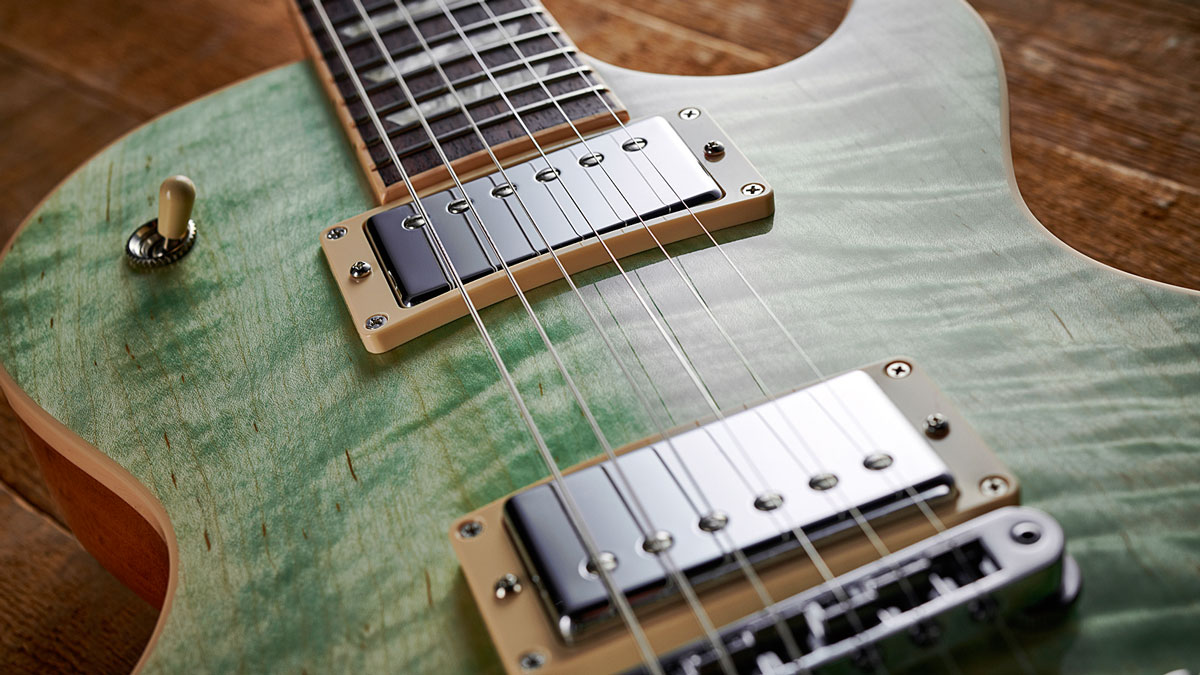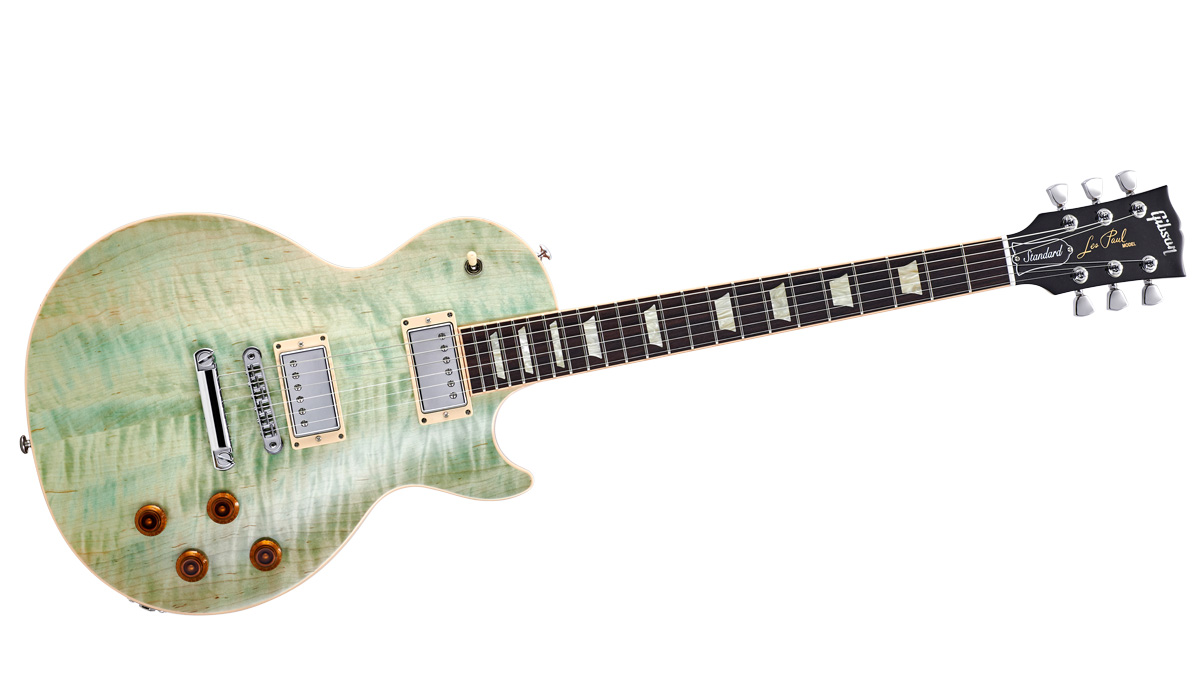MusicRadar Verdict
An iconic format with a host of contemporary tweaks - including some divisive finishes.
Pros
- +
Crisply made classic with ‘modern’ vibe from its compound radius ’board, weight relief and hugely expanded sound palette.
Cons
- -
Colour choice.
- -
The extensive weight relief, compound radius, PCB-mounted controls and push-fit connectors will be divisive.
MusicRadar's got your back
While Fender splits its guitars into series and periodically updates or refreshes them, Gibson’s main USA production division prefers the annual makeover approach.
This year’s line-up was seen by many dealers as a return to form: “A new chapter in Gibson’s illustrious history, with their focus firmly back on crafting only the world’s finest guitars!” said one. As ever, the Les Paul sits central, with eight models (if we count The Paul 40th Anniversary) bookended by the start-up double-cut Les Paul Junior Tribute and topped off with the Les Paul High Performance. Add to the list the Les Paul Studio and Studio Tribute, and that leaves us with the three most classic Les Pauls: the Standard, Traditional and Classic. Today, we’re looking at the Standard.
The majority of the guitars’ specs are what we’ve been used to, but one bold move is the colour options. At launch back in September 2018, the Les Paul Standard was offered in Trans Amber, Heritage Cherry Sunburst, Seafoam Green (as here) and Blueberry Burst; by the end of the year only the latter two colours were listed by Gibson on its website and in its spec sheets. We also get the High Performance HP-4 circuit with its expanded switching options.
Outwardly, all three of these 2019 models share the same construction (one-piece neck, headstock widening wings and two-piece centre-joined backs), though the maple top grade is highest on the Standard, rated as AAA. The Standard’s top is not in an ultra-blingy style. The Standard’s slightly worn-through-looking blue/green shows off a characterful flame.
We’ve seen numerous changes to pickups and control circuits over the past few years, and here the Classic offers expansive switching via pull/push switched volume and tone pots mounted on PCBs.
Build
Here is a Les Paul that is full of upgrades and tweaks that distance it from the vintage spec. First off, the two-piece diagonally grain-matched mahogany back features Ultra-Modern Weight Relief, which has12 small chambers and holes along with a wide channel to run the wires from the toggle switch to the control cavity. “It’s engineered to provide a solid core through the centre of the guitar to retain the classic Les Paul sound,” says Gibson master luthier Jim DeCola. “Unlike a full chambered design, this will be less prone to feedback or affecting tonality and resonance.”
Compared with the Traditional and Modern weight reliefs, the Standard’s system offers the most ‘air’ before we get into chambering. It might be the lightest of our trio but certainly still feels like a good classic single-cut. The neck also has the more modern Asymmetrical Slim taper - the bass side is slightly more rounded than the treble.
Want all the hottest music and gear news, reviews, deals, features and more, direct to your inbox? Sign up here.

In fact, the actual back to front taper is relatively slight (1.7mm), giving a very similar feel in lower or higher positions. It’s the only one of our trio to use a compound fingerboard radius (254 to 406mm/10 to 16 inches); the Gibson classic 305mm/12-inch radius is achieved around the 12th fret, we’re told. The frets are the same gauge across all our ’Pauls and are quite small in width, around 2.26mm, with a height that barely exceeds 1mm. As supplied, there’s a string height of around 1.2mm on the treble side and 2mm on the bass side, which would seem to reflect the 0.009 to 0.046-gauge strings the guitars are shipped with.
Hardware veers on the modern side with firm-feeling rear-locking tuners and the wider-travel Nashville-style bridge. There’s no toggle switch ring or pickguard, although both are part of the case candy, which also includes a leather strap and multi-tool for any adjustments.
Whatever you might think of the style or spec, it’s a very tidy piece. The gloss nitro is beautifully level showing none of the ‘orange peel’ you might have seen a few years back. We’d be tempted to give the frets a polish and add a dab of oil to the mid- brown rosewood ’board, but we could say that of numerous new guitars we have on test.
Sounds
Forgetting about all of its sonic potential, the Standard comes across as a very well sorted single-cut. Its whole style seems almost progressive, but the actual drive has a more vintage-y feel. Our advice is not to dwell on specs such as fingerboard radius, or even the frets, until you can actually get to play one. Why? Because, with a few tweaks to the setup, this Standard plays really well: clean and very responsive.
The Standard doesn’t have lots of heft, but it does have a detailed clarity, some of which is surely coming from its weight relief. In some ways you have to work a little harder, but you get back what you put in, and the range of voices here is too much to digest in even a couple of listening tests.
The Classic and Standard’s tap functions are similar, but the Standard takes these different textures and runs away with them. In mixed position and by experimenting with the tap and split options and/or those treble bleed circuits, you’re really creating your own Les Paul, for your own taste and style. Of course, if you want to run it all full up (and there’s nothing wrong with that!), you’re going to miss out: it’s with these additional shades and textures that the Standard scores.
We’re fans of the Standard’s neck shape and flat fingerboard radius, but it’s the colour that makes us hesitate. Plugged in, it’s a different story with each model sounding subtly yet quite profoundly different from a purchasing perspective. The range of sounds you can coax from the Standard is astonishing, although to our ears it has the lightest timbre, which seems to work in favour of those split and tapped sounds slightly at the expense of balls-to- the-wall Les Paul rock.
It will no doubt be a while until ‘new Gibson’ settles in and has a noticeable effect on the instruments we can buy. These interim models, however, are three strong dishes that employ existing features we’ve seen before, albeit not in quite the same combinations.
With the horrors of ‘robotic’ tuners, over-wide necks and zero frets now pretty much consigned to the past, the three aforementioned 2019 models zone in on the Les Paul in classic style (Traditional), sonically expanded (Standard) and affordable (Classic) shades. They need a little TLC, which we’d hope would be undertaken before they’re sold, but they’re tidy, not over-priced and have the right name on the headstock.
Dave Burrluck is one of the world’s most experienced guitar journalists, who started writing back in the '80s for International Musician and Recording World, co-founded The Guitar Magazine and has been the Gear Reviews Editor of Guitarist magazine for the past two decades. Along the way, Dave has been the sole author of The PRS Guitar Book and The Player's Guide to Guitar Maintenance as well as contributing to numerous other books on the electric guitar. Dave is an active gigging and recording musician and still finds time to make, repair and mod guitars, not least for Guitarist’s The Mod Squad.

